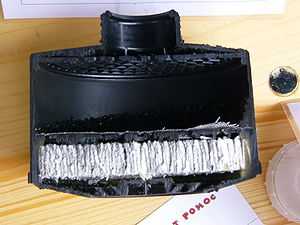Sorbent

Cross-section of a gas mask filter, with sorbent material visible
A sorbent is a material used to absorb or adsorb liquids or gases. Examples include:
- A material similar to molecular sieve material, which acts by adsorption (attracting molecules to its surface). It has a large internal surface area and good thermal conductivity. It is typically supplied in pellets of 1 mm to 2 mm diameter and roughly 5 mm length or as grains of the order 1 mm. Occasionally as beads up to 5 mm diameter. They are typically made from aluminium oxide with a porous structure.
- Materials used to absorb other materials due to their high affinity for doing so. Examples include:
- In composting, dry (brown, high-carbon) materials absorb many odoriferous chemicals, and these chemicals help to decompose these sorbents.
- A sponge absorbs many times its own weight in water.
- A polypropylene fiber mat may be used to absorb oil.
- A cellulose fiber product may be used to absorb oil.
- The granular gel material in a baby diaper will absorb several times its original weight in urine.
- Polymethylsiloxane polyhydrate (PMSPH) is a gelly-like polymeric organosilicon compound. PMSPG is an sorbent designed for binding toxic substances of different nature, pathogens and metabolites in the gastrointestinal tract and their excretion.
- Desiccants absorb water, drying out (desiccating) the surrounding materials.